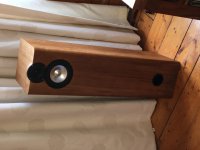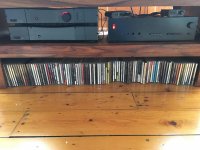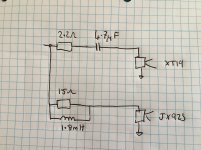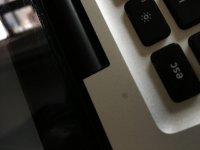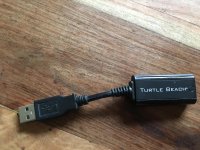Hi all,
A few years back I built a MLTL speaker based on the Jordon JX92S and Vifa XT19TD00
Tweeter to match JX92S
Jordan JX92S Fullrange Loudspeaker Driver / Transducer
XT19TD00-04 – Tymphany
I’ve always been curious as to whether a dsp crossover would improve the sound.
What with a bit of time on my hands and a couple of hundred quid I decided to take the plunge....
A few years back I built a MLTL speaker based on the Jordon JX92S and Vifa XT19TD00
Tweeter to match JX92S
Jordan JX92S Fullrange Loudspeaker Driver / Transducer
XT19TD00-04 – Tymphany
I’ve always been curious as to whether a dsp crossover would improve the sound.
What with a bit of time on my hands and a couple of hundred quid I decided to take the plunge....
Last edited:
Isn't the Jordan JX92S a full-range driver and the speaker is therefore without a crossover? Perhaps you meant DSP EQ?
Please let us know how it works. I'm a past fan of the MiniDSP 2x4. It has sat unused for a couple years, because I moved to a JRiver based active EQ (8 channels of active amplification). Heck, I would give you mine but you are a bit far away. Due to the mysteries of international shipping, you can probably one one new delivered cheaper than I could ship mine to you 😀 My only complaint against the 2x4 was the noise floor -- an issue if you must run your amps maxed out. Switching to a balanced DAC solved that issue for me.
Isn't the Jordan JX92S a full-range driver and the speaker is therefore without a crossover? Perhaps you meant DSP EQ?
Yes indeed, but I’d always found the high end to be a bit harsh / zingy on certain music, so I partnered it up with a tweeter.
It may seem that I’m defeating the purpose of using a full range but at the time, I reasoned that having a nice flat response over a wide bandwidth could make the crossover design easier, or at least allow me to explore more options, such as a first order design.
Please let us know how it works. I'm a past fan of the MiniDSP 2x4. It has sat unused for a couple years, because I moved to a JRiver based active EQ (8 channels of active amplification). Heck, I would give you mine but you are a bit far away. Due to the mysteries of international shipping, you can probably one one new delivered cheaper than I could ship mine to you 😀 My only complaint against the 2x4 was the noise floor -- an issue if you must run your amps maxed out. Switching to a balanced DAC solved that issue for me.
That’s very kind of you. The minidsp arrived last week, so no need....
I went with the minidsp NanoDigi. It has more outputs than I need, but at least it is digital in, digital out, so hopefully no noise.
I’m going to try posting some pictures of the setup. It’s been a while since I’ve been on the forum, so excuse me for multiple edits
Please let us know how it works. I'm a past fan of the MiniDSP 2x4. It has sat unused for a couple years, because I moved to a JRiver based active EQ (8 channels of active amplification). Heck, I would give you mine but you are a bit far away. Due to the mysteries of international shipping, you can probably one one new delivered cheaper than I could ship mine to you 😀 My only complaint against the 2x4 was the noise floor -- an issue if you must run your amps maxed out. Switching to a balanced DAC solved that issue for me.
Do you want to sell your dsp? I have one but the person I bought it from had taken the rca jacks off and the solder pads came off when I tried to install them back. I’m just east of Orlando in Deltona. Please message me
Thanks
Carl
And this is the audio setup, which is the sum total bit of audio kit I have around the house
DACs:
For the tweeter, a SMSL SD-79311
For the woofer, an Anagram D-A
Amps:
For the tweeter, a Rega Cursa 3 and Rega Maia
For the woofer, a homemade classAB mosfet amp
Audio source:
Rega Jupiter (not shown)
Google chrome cast audio
DACs:
For the tweeter, a SMSL SD-79311
For the woofer, an Anagram D-A
Amps:
For the tweeter, a Rega Cursa 3 and Rega Maia
For the woofer, a homemade classAB mosfet amp
Audio source:
Rega Jupiter (not shown)
Google chrome cast audio
Attachments
A bit of an experimental setup...
If the things works out I really really want to replace almost everything by a couple of these:
Hypex Electronics B.V.
But I would have to sell almost everything to afford them!
If the things works out I really really want to replace almost everything by a couple of these:
Hypex Electronics B.V.
But I would have to sell almost everything to afford them!
First.... a bit of history.
I’ve tried many many passive crossovers and equalisers with these speakers, including
1. Just the JX, driven straight from the amp
2. Just the JX, with a BSC (inductor // resistor)
3. Third order Xover
4. A “special”
The latter was a first order tweeter xover, and a BSC compensator for the JX.
This was the most successful. I had no measurement gear and adjusted it to sound as close as possible to a Sonos Play:5
I’ve tried many many passive crossovers and equalisers with these speakers, including
1. Just the JX, driven straight from the amp
2. Just the JX, with a BSC (inductor // resistor)
3. Third order Xover
4. A “special”
The latter was a first order tweeter xover, and a BSC compensator for the JX.
This was the most successful. I had no measurement gear and adjusted it to sound as close as possible to a Sonos Play:5
The bass section acts as a baffle step compensator, and takes down the treble from the Jx fullrange.
As you can imagine there is a wide overlap between the two units.
I don’t think this is a technically “good” design, but sounds nice in the listening position with the speakers toed in to remove some more of the treble from the Fullrange driver which has a very directional response at high frequencies.
One thing I’ve always noticed is that the design does not sound flat away from the listening position.
Has anyone heard of the “studio doorway test”? If the sound is good in the doorway, it’s a good sign. Well this design does not sound good in the doorway.
So my thought process is:
“How much better can we do with some measurements and a minidsp?
As you can imagine there is a wide overlap between the two units.
I don’t think this is a technically “good” design, but sounds nice in the listening position with the speakers toed in to remove some more of the treble from the Fullrange driver which has a very directional response at high frequencies.
One thing I’ve always noticed is that the design does not sound flat away from the listening position.
Has anyone heard of the “studio doorway test”? If the sound is good in the doorway, it’s a good sign. Well this design does not sound good in the doorway.
So my thought process is:
“How much better can we do with some measurements and a minidsp?
And this little bad boy is going to be my measurement mic.
Before you throw up your hands in horror, I’m using this as a learning experience in loudspeaker measurement before I cough up a hundred quid on a UMIK-1
And I think I can compensate for the response...
Before you throw up your hands in horror, I’m using this as a learning experience in loudspeaker measurement before I cough up a hundred quid on a UMIK-1
And I think I can compensate for the response...
Attachments
Last edited:
And I’m going to use this as my soundcard, fed straight into the optical input of
the minidsp. This will allow me to compensate for DSP delays, DAC delays (I’m using a different one for the tweeter and woofer and compensate also for anything else in the signal path.
the minidsp. This will allow me to compensate for DSP delays, DAC delays (I’m using a different one for the tweeter and woofer and compensate also for anything else in the signal path.
Attachments
Last edited:
This is the raw tweeter response, measured with a 5ms measurement window
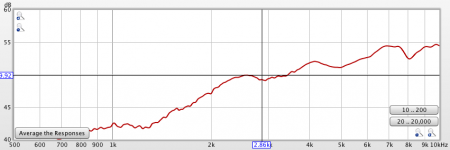
Not a pretty sight, compared to the published response
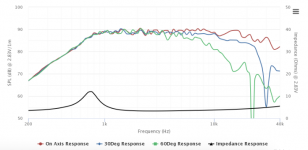
Some of the slope is due to the measurement window. Here is the response, with 1/12 octave smoothing, no window.

Next the woofer responses, with the 5ms window

and no window, 1/12 octave smoothing

It's hard to separate what we are looking at: the driver responses, room response, microphone response.

Not a pretty sight, compared to the published response

Some of the slope is due to the measurement window. Here is the response, with 1/12 octave smoothing, no window.

Next the woofer responses, with the 5ms window

and no window, 1/12 octave smoothing

It's hard to separate what we are looking at: the driver responses, room response, microphone response.
This is the measured impulse response of the tweeter (+cabinet+room+mic...)
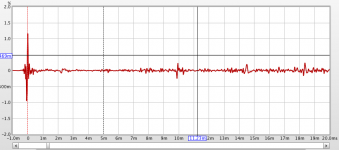
and the corresponding woofer
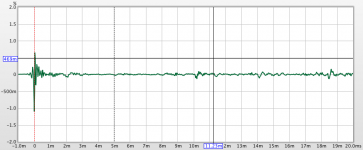
Both show some clear reflections around 10ms and later
and the combined response (both drivers enabled)
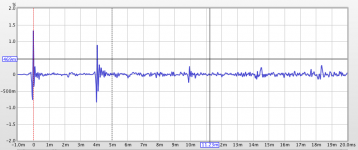
that's interesting...
This is showing a large delay between the two drivers. Each impulse response shows the complete system response, including mini-DSP, DAC, amp.
The first impulse is the tweeter and the second is the woofer. There's over 4ms delay in there, around 174 samples at 44.1kHz sample-rate. Assuming a linear-phase (symmetric) FIR 2FS interpolation filter in the DAC, that's a 700-tap filter!

and the corresponding woofer

Both show some clear reflections around 10ms and later
and the combined response (both drivers enabled)

that's interesting...
This is showing a large delay between the two drivers. Each impulse response shows the complete system response, including mini-DSP, DAC, amp.
The first impulse is the tweeter and the second is the woofer. There's over 4ms delay in there, around 174 samples at 44.1kHz sample-rate. Assuming a linear-phase (symmetric) FIR 2FS interpolation filter in the DAC, that's a 700-tap filter!
Harsch Time-aligned crossover
Fortunately, we can compensate for that delay in the mini-DSP.
Before I realised there was a large delay in there, I tried a few crossovers (LR2, LR4 etc) and was surprised how innocuous the 4ms delay was.
This put the idea into my head that I should try the opposite extreme: a time aligned crossover:
So, first stop on the crossover journey: 2kHz Harsch, inspired by this one
S. Harsch XO
Given the poor microphone response and as yet uncertain room acoustics, I think the best we can do at this stage is focus on the XO region (2kHz). We know both the woofer and tweeter have a relatively flat response in the 2kHz-3kHz region, so if these are matched in amplitude, the response of the microphone will be less important.


The delays and amplitude were tweaked to get a decent null with the polarity of the tweeter inverted
The step response is as follows:
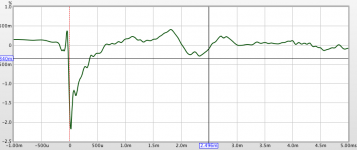
This shows an ok step response (the triangular shape is because the measurement started 500Hz, equivalent to a high-pass filter).
Fortunately, we can compensate for that delay in the mini-DSP.
Before I realised there was a large delay in there, I tried a few crossovers (LR2, LR4 etc) and was surprised how innocuous the 4ms delay was.
This put the idea into my head that I should try the opposite extreme: a time aligned crossover:
So, first stop on the crossover journey: 2kHz Harsch, inspired by this one
S. Harsch XO
Given the poor microphone response and as yet uncertain room acoustics, I think the best we can do at this stage is focus on the XO region (2kHz). We know both the woofer and tweeter have a relatively flat response in the 2kHz-3kHz region, so if these are matched in amplitude, the response of the microphone will be less important.


The delays and amplitude were tweaked to get a decent null with the polarity of the tweeter inverted
The step response is as follows:

This shows an ok step response (the triangular shape is because the measurement started 500Hz, equivalent to a high-pass filter).
Last edited:
Listening impressions
Already, the design sounds a lot better than the best passive design I tried with these drivers.
The mini-DSP allows easy switching between XO designs, which makes A-B testing very easy.
I configured a full-range design (JX92S+baffle-step, tweeter disabled) and switched between the two.
The difference is night and day. The 2-way design has a much more natural response - vocals are less coloured, high frequencies are better.
The imaging is also better on the 2-way design, which is surprising considering the full-range design is a better point-source.
Would be great if anyone has some advice on measurement windows vs. smoothing. First step could well be to get a decent microphone, once international shipping is back to normal.
Already, the design sounds a lot better than the best passive design I tried with these drivers.
The mini-DSP allows easy switching between XO designs, which makes A-B testing very easy.
I configured a full-range design (JX92S+baffle-step, tweeter disabled) and switched between the two.
The difference is night and day. The 2-way design has a much more natural response - vocals are less coloured, high frequencies are better.
The imaging is also better on the 2-way design, which is surprising considering the full-range design is a better point-source.
Would be great if anyone has some advice on measurement windows vs. smoothing. First step could well be to get a decent microphone, once international shipping is back to normal.
Last edited:
- Home
- Loudspeakers
- Multi-Way
- Jx92S + miniDSP
